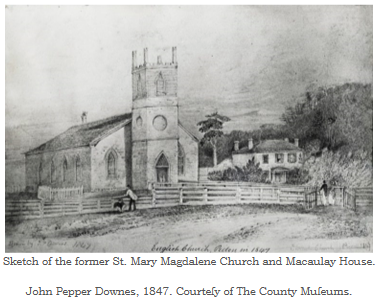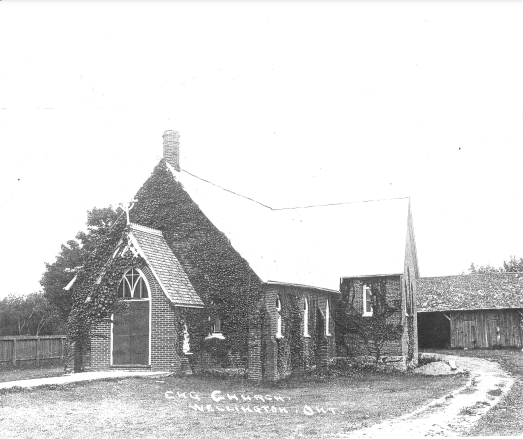

St. Andrew’s – A Brief History
The church of St. Andrew’s Anglican, Kente Parish, lies in the diocese of Ontario. It began as a mission church of Christ Church Hillier in the nineteenth century. Prior to 1855, the Wellington Anglican community was served by traveling missionaries. As late as 1840, only Carrying Place and Picton had dedicated Church of England clergy attached to them, with John Grier at Carrying Place and William Macauley in Picton.
In 1847, Bishop Strachan of the Diocese of Toronto (before the Diocese of Ontario was formed) appointed Reverend Robert Gregory Cox “to officiate in the churches at Hillier” (built in 1846) “and Demorestville, to give four Sundays a year to Marysburgh, and travel on weekdays to other unprovided parts (including Wellington).”
Construction for the first Anglican church in Wellington was begun in 1852 and completed in 1855. The church was built by the parishioners of Christ Church Hillier under the guidance of Reverend Cox. St. Andrew’s parishioner and historian Michael Korn has done substantial research on the life of Reverend Cox, who was English-born and lived briefly in the United States. Sadly, Cox died in a railway accident en route home to his parish of Brampton from Synod, just ten years later, in 1862.
The original building consisted entirely of that portion now containing the east and west transepts and was a very small space. However, it is clear that “a larger building was planned from the beginning” as the church has “unusual and handsome open beams” that were part of that early building. Consistent with other Anglican churches of the time, the church faced east, with the chancel being where the small chapel is now and the door likely on the south side of the building.

Weather in Prince Edward County was frequently a challenge, for clergy and parishioners alike. One memorable Christmas, the youth of St. Andrew’s traveled to Hillier to perform in a Christmas concert and were unable to travel home. In that year of 1916, there was still a passenger railway through the County. Having traveled by train from Wellington to Hillier, the group ended up snow-bound overnight in the Hillier station. Weather can still be a challenge, more than one hundred years later. Following two years of Christmas services being locked down by the COVID-19 pandemic, St. Andrew’s parishioners again had to face Christmas away from the church in December of 2022 when a mighty storm shut down power, downed trees, and closed roads over Christmas.
.png)
Social activities and community missions were a key part of church life from early on, with Christmas concerts and summer picnics enjoyed by all. Soon a Sunday school was begun. In 1893, the Women’s Auxiliary was formed to raise money for missions. Then in 1969, The Guild and The Women’s Auxiliary joined to create The Anglican Church Women. The ACW is still active today at St. Andrew’s.
The next significant physical change to the church occurred with the expansion of the church in 1870. At that time, what was the original building became the cross piece on the new long axis of the church, and so now, instead of facing east, the church is oriented to the north-south, with the entrance at its south end. Then in 1910, the church was bumped out towards the north with the construction of a new chancel. At the same time, renovations were undertaken to bring electricity to the church.
In 1912, the murals of the four evangelists on the north wall were painted by Peter Charles Browne. Originally, twelve apostles were painted; at some point the eight on the side walls were painted over, leaving the four evangelists on the back wall of the chancel. Dark and dirty by 1994, a restoration was undertaken by Browne’s grandson, Thomas. Then, in 2018, due to the deteriorating condition of the wall underlying the murals, the parish decided to accept the generous offer of our parish secretary, professional artist Tracy Douglas, to create four new paintings, identical in outline and content but with brightened colour and new faces. The paintings were completed by Tracy over the course of a year and installed in the chancel.
.png)
Buildings attached to the back of the church have evolved over time as well. The original building behind the church was a drive shed for horses and wagons, buggies, or sleighs. A parish hall was built in 1961, and then a further renovation was completed in the 2010s, adding to the office area with an addition allowing room for the clergy office, sacristy and a general purpose room called the St. Alban’s room.
In 1967, Christ Church Hillier (which was a part of the Parish of Kente along with St. Andrew’s) ceased having regular services, and a number of items were brought to St. Andrew’s. The side chapel on the east wall of the church (the original chancel) is now called the Memorial Chapel and contains a number of these items, which are used during Wednesday Eucharist held in that space. And so, the church that built St. Andrew’s has in its way come to reside within the walls of our church. The parishioners at St. Andrew’s still feel a strong affinity to Christ Church Hillier. Every year a Decoration Day eucharist and lunch is hosted by St. Andrew’s. The families of those buried in the Christ Church cemetery, also the cemetery for St. Andrew’s, are invited to attend , and after the service and lunch, many go to the cemetery to lay flowers on the graves of family members.
The Parish of Kente, which at one time merged four community churches into one parish, is still the name of our parish although the community churches within this parish have, over time, reduced to one as churches have closed and populations have changed.
The most significant recent physical change was the replacement of the roof of the church in 2023, swapping out the beautiful but no longer effective cedar shingles for a more durable (and also lovely) metal roof.
In the life of the church, the choir and the Sunday school were long active, but are “lying fallow” as of this writing. Many organizations and traditions within the church continue to thrive since the nineteenth century, and new ones have developed over time. Our church garden, with flowers bordering the church building, is maintained by church volunteers.
Significant community missions are a core part of church energies and resources. Chief among those would be the What-Not Shop, a second-hand store in the basement of the church that is run by volunteers. Proceeds from the shop go to local charities. Other missions include the Endowment Fund, the Angel Tree Campaign, and the Seniors Ministry. In 2023, Lay Reader Jan Davey instituted a winter food mission for the community with a weekly lunch program called “Soup’s On”.
Scriptural discussions at Wednesday Eucharist, periodic study programs, guest speakers, and other initiatives also help to bring in the world outside and stimulate reflection.
While St. Andrew’s is a church that is committed to preserving its history and valuing the longevity of so much that it offers, it is also an energetic parish with a keen eye on the future. We look forward to the new life that, over time, change necessarily brings.
Historical facts and quotes excerpted from the booklet “St. Andrew’s Church: 150th Anniversary 1852-2002”, researched and compiled by Janet Lunn and Marjorie Wiltse (2002). All pictures and artwork, unless otherwise noted, are courtesy of the Marjorie Wiltse Collection.